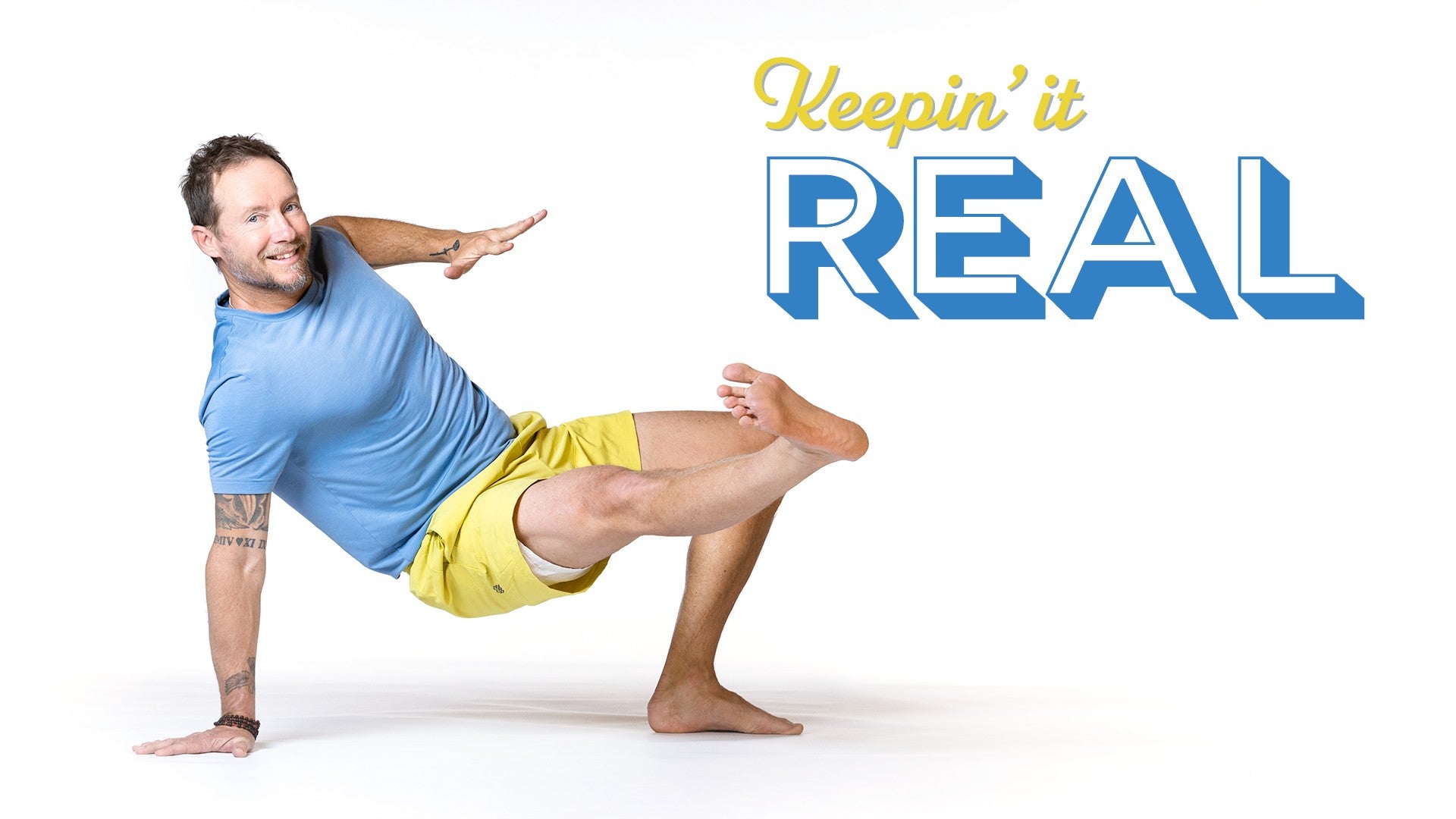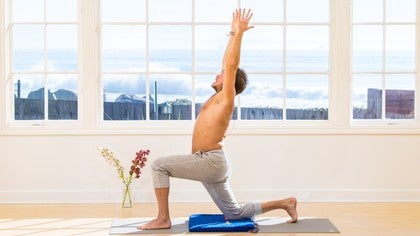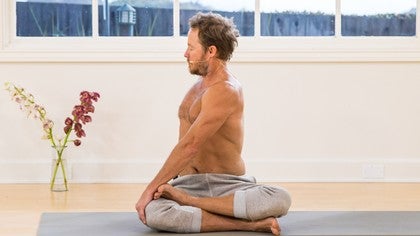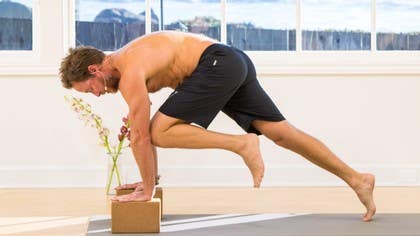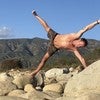Description
About This Video
Transcript
Read Full Transcript
(waves crashing) Hey there, my name is Robert, welcome back, it's really good to see you again. This is going to be a sequence that I think is really helpful. It's a sun salutation variation, so it involves some movement, some forward bending, some low lunging, right? So I'll take you through it in the most basic way for the first part of it and then we'll build gradually, and so wherever you are, right, wherever you are in your body and your interests, you can take it as far as you like. So if you're super super beginner and you have some hesitations with growing into it, stay with the first part.
And if you want to go come with me through the whole thing, let's do it, alright? So, as always, my thing is, is like, I'm teaching you something that I think, or I know has been very beneficial on so many levels for me and my life, okay? So I'm trying to share it with you in a very useful, simple, straightforward way. Alright, so hopefully it transfers to you, you can enjoy it, thanks for joining me once again. So we have a mat, you're gonna, I would encourage you, strongly encourage you to grab a blanket.
A blanket, a thick blanket or a towel, something that I'll show you when we end up moving will pad for your knee, okay? It'll just take out one more element of discomfort, possible discomfort, so make your way to the front of the mat, and I'll kind of cue you through mountain pose and we'll build from there. Okay, ready to roll? Let's go. So front of the mat.
I like my feet about hip width. So that brings me to something, right? Hip width or feet together or a little bit wider, if you've practiced with another teacher and they say one thing, right? And then I say this, it's just there are so many different ways to share this, so if you've done it one way and it feels better for you to bring your feet together, do that. And that goes for the whole 30 minute sequence that we'll be together, okay?
If I say something but you like to do it a different way, check in with that, see how it feels, but maybe try it my way, it doesn't work, go back the other way, alright? Have fun. Okay, so feet hip width. And what I like to do, right, is lift your toes. Lift your toes and begin to find a really good connection.
The bones, begin to you feel your bones kind of spread out and press down. So think of it as if you're gonna build a house, right? So during this practice, right, this 30 minute practice, we will be building many different houses, right? Poses, like call the posture a home. You build a home, you've gotta have a foundation, you have to have something to stand on, right?
Or to build on. So we'll go through it and build it the best way we possibly can, and the really cool thing, once you've got that part done, and it becomes more instinctual and intuitive, you know how to build your house, to actually then live in it and reside in it and feel your place in it, right? And you feel at home. You want to feel at home in your body, so that's part of this practice is becoming more and more comfortable with being in your body, right? Okay, so enough of that chit chat, but I did want to share that.
So, build a foundation. Feet, bones in your feet, when you lift your toes can you feel some musculature up through your lower legs. And if you squeeze your thighs you might feel your kneecaps lift a little bit. So what you're trying to do is feel the legs strong and supportive. And one thing that we'll talk about as we move through this is this action, this, forward tilt, right?
Anterior tilt they call it. Or this tilt, okay, you wanna stay more in the neutral range. We could do a whole sequence just talking about that, but I'm gonna talk about neutral pelvis a lot, alright, so here we are, neutral pelvis, and one cool thing about that is if I'm here, and I bring it into a neutral position, this region, that core region of the body begins to kind of shore up a little bit, okay? So legs, neutral pelvis, long spine, open chest, so one thing I like to do is have my arms down kind of like so with my palms forward. If my palms are back, this rotates in and things get a little closed off.
So if you're a natural stander like this, it's a good practice to open up like so. And also if you can see, here, arms are strong and my back is a little more engaged which then will open up the chest. Okay, so, the next phase would be the neck and head. So long neck, notice where the tilt is in the head. So maybe the chin can come down just a tiny bit and the head presses back just a tiny bit.
So for me, this feels good, I feel really supported, I feel strong, but I also feel relaxed. This for me is a nice mountain pose, good place to start. So as always, right, we can talk all day about the body and the cuing, right, the physical structural cuing, but where is your breath now? So let's take at least five full breath cycles together. So breathing in, and breathing out.
No specific way, right? Let the breath fall in and fall out. You can even close your eyes and begin to find where you are, where your body is on the mat. It may be challenging for you with your eyes closed, it may be a balancing pose all of a sudden. Breath falls in, breath falls out.
One more time, breathe in, and breathe out. Inhale, circle the arms out and up. The arms can be straight or you can bend them a little bit if your shoulders say no, right? So breathe in, maybe even tip back a little bit, but make sure this isn't happening, right, so tailbone down, coarse, nice and strong, spine long, breathe in, and then palms draw all the way down the center of your body, a little bend in the knees, and a fold. So that's the exhale, right?
So feet are hip width, hang here for a breath or two. Don't worry about being able to touch your toes, eliminate that, it means nothing, okay? So it means something, okay, I'll come back up for a moment. It means something, right, I won't totally disregard that, it means something if when you started you couldn't, and after a few practices or a year, all of a sudden you can. I do give that merit, but don't place a lot of emphasis on being able to touch your toes and having that be a success, okay?
Hopefully that makes sense. So breathe in, and breathe out. (exhaling) Press your palms or your fingers or something around your shins, just below your knees. And then lift your chest as you pull your elbows back a little bit, lift your chest up, pull the belly in. So now I can't really see myself but I'm assuming I'm sort of flat on my back. This region of my body is nice and braced, but I'm lengthening my spine, knees are bent, you can even press your palms into your hip creases and push back and lengthen the top of your head forward.
Now breathe in here. Fold as you breathe out. (deep exhaling) Bend the knees, roll up. Pause. So, now grab your blanket, okay?
This is going to help you quite a bit. Grab your blanket or your towel, or some kind of something, right? Now place it on your mat about middle of the way. Now, I'm told it's really important to have a nice clean surface as you, you know, it's part of the practice, let's call it part of the practice, right? You don't just lay your blanket out sloppy, you put it down, it's like uh, similar to what the definition of vinyasa yoga is, basically right, is to place with special care, right?
So this is your sort of, scene, set it up. Be mindful about it. I'm not always this mindful, but I'm on camera, so I gotta be. No, I am, believe me. (laughing) Okay, so this is here in the middle so that when we put our knee down, it's supported and comfortable, alright?
So, now let's start over. Mountain pose. So it's like feet, legs, pelvis, spine, chest is open, back is strong, neck is long, head is neutral, breath is flowing, right? Now breathe in. Breathe out.
(deep exhaling) Breathe in, half forward bend, right? Now breathe out, bring your right foot back. Bring the back, or the right knee down on that really smooth surface you've just created. Okay, now we'll talk a little bit about the lunge. So you can see here, the way I learned it, it's called a 90 90 set up.
So my front leg is in a 90 degree angle. Joints stacking here, correct. And my back leg has a 90 degree, right? So what this will do, it will free the pelvis up for that neutral position. So if I find myself way back here, which feels pretty good for me, this region is in lock down now, so if I've got any pain in my back, I'm just gonna be here suffering, right?
So what I wanna do is I wanna start here, now I can really move through here, okay? So now I wanna draw that tailbone down. You can see, you can kind of notice, you might notice on the other side, might be more visible. But, here we are. Now the benefit of this is that you've drawn this down and your low back then kind of extends and lengthens or becomes neutral as opposed to this severe curve which may or may not feel good for you, right?
So, and then that draws down and then this region, it becomes a little bit more alive, strong. Okay, here the next phase for me would be arms are up. There are so many different ways you can bring your arms, so one favorite of mine, especially if I'm teaching basics or beginner style right now, is to bring your arms kind of parallel with the floor, right, level with the floor. And then kind of create this field goal shape. And draw the fingers forward, keep your elbows up, and pull the elbows back, but mindful that you don't all of a sudden do this, right?
Don't compromise all the work you've got. Pull the elbows back and then palms forward. And now you've got this stretch across the chest and shoulders and your back is actually doing some work now. And you can work with doing some, this kind of movement, right, that's a whole other sequence and class, but it, open up, you can even take a Y shape, you can reach back behind you and interlace your fingers. Okay, kind of endless, right?
So boom. Low lunge, so we've exhaled back into lunge, right? We inhaled, we came up into your version, right? And now we're gonna exhale the hands down, continue to exhale as you step up and fold. Inhale, come up halfway.
Full exhale. Reach your seat back a little bit. Begin to imagine, you've been told a million times, right? Well maybe not a million, lift with your legs, not your back, right? So begin to create this imaginary heavy object in both arms, and lift with your legs, pull your belly in, strong, neutral spine, and then lift all the way up, take a deep breath in as you do so.
And (breathing deeply). Okay, breathe in, we'll do the other side. Breathe in. And exhale. Forward bend.
Inhale, half forward bend. And now exhale the left foot back. Finish the exhale, right? Inhale. Come on up.
And one thing I didn't say on the other side, so here, if I let this come forward, right, and then I lift my arms up, everything, I don't know about you, but it just doesn't feel good, and my core is not engaged, I've got more like, lordosis thing, that sway back which is no good for anybody, really. And my shoulders are a little tight, right? And I'm not getting that nice stretch up through the hip flexor region. So, what we're gonna do is bring it back, 90 90, tailbone down, now just by doing this, (mimicking whooshing) tons of stretching and lengthening happening, okay? So now I've got that.
Then the arms. Your version, right? You can even put the hands behind the head, pull the elbows back. This version can be a little bit more labor intensive, right, you're actually engaging more musculature as opposed to like laying into this version, right, this like, right, which feels nice, but I'm assuming, right, we might want to work with this. So breathe in, reach up.
Breathe out, hands down. Finish the exhale. Loosen the head, loosen the shoulders, and then begin to engage, right, so bent knees, half lift, half lift to lengthen your spine. (mimicking lengthening) Right, lengthen out, to fold back down. (exhaling) Strong legs, rise up, breathe in.
And breathe out. (exhaling) I'm gonna take you through one more version of the half version, so that's the half version. Take you through one, breath by breath, okay? Then we'll build on it, and we'll get a little more heavy in the cues again, and then we'll build breath by breath by breath again, right? You with me?
Alright, good. Here we go. Breathe in. Arms up overhead like steeple pose, breathe out, forward bend. (exhaling) Breathe in.
Half forward bend, right? Breathe out, low lunge. Knee down, finish the exhale, right? To breathe in to your version of the lunge. Big breath in, and exhale.
(exhaling) Inhale. And exhale. (deep exhale) Knees bent, strong legs, strong core, long spine, inhale, and exhale. (deep breathing) Breathe in. And breathe out.
(deep breathing) And breathe in. Left foot back, breathe out. Finish the exhale, inhale to rise. And exhale hands down, little shift up, finish the exhale. Inhale, lift halfway.
And exhale, fold. (deep exhale) Inhale all the way up. And exhale. Okay. So that's that half version of the sun salutations, right?
The sun salutation with the low lunge. It's the half version, we left out what's called like a vinyasa transition which requires downward dog, plank, et cetera, okay? So now what I'll do is I'll take you through that. But keep in mind, like I said in the beginning, if that portion there is enough for you, stay with that and practice that and really refine that. And then grow into the rest, right?
So let's work on that, okay? So similar start, mountain pose, I won't get into all the details right, we could all be all day with mountain pose. So, breathe in. Steeple. Breathe out, forward bend.
(deep breathing) Breathe in, half forward bend. Breathe out. Right foot back, knee down, finish the exhale to rise on the inhale. Exhale, this time you bring the hands down, step back into plank pose, oh downward dog, my apologies, downward dog. So you've gone from lunge, you've exhaled back into downward dog, now you breathe in, you can keep the blanket there, if it's in the way, let it go.
Breathe in into plank pose. We haven't really gone through this one yet so, feet are in that hip width position, hands below the shoulders, notice how I'm not sagging, right? Low back doesn't like it, core is lazy, it's kind of not really effective, right? So I also don't want to lift up too high. So I want to do is kind of find this position where my back, from the back of my head down through my tailbone, my low back, is kind of flat.
And then there may even be an angle from my butt down to my heels, right? Maybe, maybe not. But I feel like it's probably close enough. There it is. Belly strong, now breathe in.
As you breathe out, let's bring the knees down. (exhaling) Point the toes back. Again, fiddle around with the blanket, make it work for you. Breathe in for cobra, lengthen the spine, press the tops of your feet into the mat, strong legs, breathe in here. Breathe out, tabletop.
Inhale, curl the toes under. Exhale, downward dog. (exhaling) So we brought the right foot back initially, now we're gonna bring it back up so that we get the lunge on the opposite side. So you're gonna lift that right leg up, take a deep breath in, and you can exhale, step it all the way up to your right thumb. Bring the knee in, maybe even lean to the left a little bit.
Tent up on the right fingertips, and kind of like get it that way, right? So there's this way, breathe in, right, then you set the knee down. Or what I like is once you come into downward dog, bring the knees down, pause, take a breath in. And then bring the right foot up like so. Inhale.
And then exhale to hands down, step up, fold. (exhaling) Strong legs, rise up. And exhale palms to the chest. (deep breathing) We'll do the same thing but we'll lead with the left initially, then we'll lift up with the left, send it up, alright, so let's try it again. Breathe in. Breathe out, forward bend.
(exhaling) Inhale, half lift. Exhale, fold. Step the left foot back, bring the knee down, rise up on the breath in. Good, breath out, hands down, step back into downward dog. Refine it, hang out in downward dog as long as you'd like.
Move through plank pose on the breath in. I'll lower down without the knees this time, watch my elbows, elbows stay over the wrists, okay? So you might want to from plank shift forward, but when you shift forward, don't shift forward like so, right, keep that honest. The integrity of the plank intact. (deep breathing) Point the toes back, lift up, cobra.
Tabletop exhale. Curl the toes under, breathe in. Breathe out, downward dog. You can do it from the knees, right? Bring the knees down, step up, lunge, right, which is perfect.
Or you work on this entry, right? So the left leg lifts, take the breath in. And you may land like so, right? It's like, ugh. You're like (groaning).
You're so frustrated with yourself initially, right? But it's okay. Let that knee come down, let the left foot land wherever it does and just help it along and get it there, and trust, I promise you, with practice, one day you're just going to be like (mimicking whooshing). So sweet, right? So, let's see.
So back into downward dog, you lift that left leg up, breathe in, and you can cheat it a little bit. It's not really cheating, it's just another way to do it. Bring the knee down, finish that breath right, that exhale. Inhalation up. Exhalation hands down.
Forward bend. Hands into the shins, half forward bend, breathe in. And (exhaling) deep breath out. Inhale. And exhale.
I'm gonna take you through a couple cycles now, right? So we've done some cuing, some heavy cuing on some things. Lighter on others. Do what you can, we'll try to go through this breath by breath by breath, okay? So, mountain pose.
Inhalation, arms over head. Exhalation, forward bend. (exhaling) Inhale, half lift. Exhale, right foot back, low lunge. (exhaling) Finish the exhale, rise up on the inhale.
Exhale, hands down, lift that foot up off the mat, downward dog. Plank pose on the breath in. Breath out, either use the knees or not (exhaling) to lower. Move through cobra. If you're an upward dogger, of course, go ahead and come up into upward dog.
Nice little transition back into table top as you exhale. Inhale, curl the toes under. Exhale, downward dog. Lift the right leg up, breathe in. Breathe out.
Step it up, knee down as you, so breathing out, (exhaling) finish, inhale. Exhale. (deep breathing) Inhale. Exhale. (deep breathing) Inhale. Exhale. (deep breathing) Inhale. Exhale. (deep breathing) Inhale.
Exhale, left foot back, knee down, inhale. Exhale, downward dog. (exhaling) Inhale. Exhale. (deep breathing) Inhale. Exhale.
Curl the toes under, breathe in. Breathe out. (exhaling) Left leg up, breathe in. And breathe out. Inhale. Exhale. (deep breathing) Inhale.
Exhale. (deep breathing) Pause in mountain, palms to the chest. Take a few moments to kinda like see how you feel. Notice any difference, heart rate up, a little perspiration, a little heat. Feel a little more alive. Whatever it is, right?
So there isn't any one way that you're gonna feel after this, right? It's unique and different for everybody. The experience is really different, I think. So that sequence there done in the beginning, done at the end, or at least not the end, but the full version versus half. You can do that in the morning.
Start out, start your day first thing with those sun salutations, right? Like salute the sun, "Thank you sun," right, "for being here, providing everything, this life, "this amazing, beautiful life I have." So it's a little acknowledging that, and then it's just simply moving through your body, right? I guarantee, it's a big guarantee, I know, but done the right way for you, right? This is a pretty good example of what you can do, but done your way, you'll feel better afterwards, you just will. But like anything else, right, you want something, you gotta do a little work to get there, to earn it.
So, give it a shot, morning, midday, afternoon, evening. And the other thought, right, I had this wonderful conversation with a very bright yogini. She mentioned, right, in the morning it's great, but you know, in the middle of the day, afternoon, it's a great way to kind of restart your day also. Like reboost, refocus. So however any of this language and movement can help you and serve you, I'm super happy to be able to offer it to you, so thank you so much for joining me once again.
Big breath in, (inhaling), namaste, thank you, thank you, thank you, thank you, have an awesome day.
Keepin' it Real
Comments
You need to be a subscriber to post a comment.
Please Log In or Create an Account to start your free trial.
